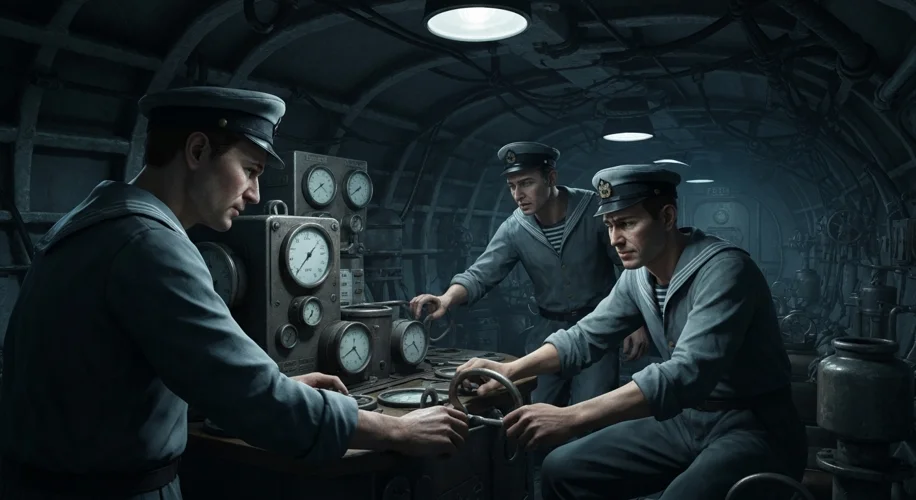The ocean, vast and enigmatic, has always been a theater of human endeavor, from exploration and trade to, tragically, warfare. For centuries, naval power was defined by the visible might of surface fleets – grand battleships and swift cruisers, their cannons roaring across the waves. But beneath the surface, a new, silent predator was emerging, one that would forever change the calculus of naval conflict and the very concept of sovereignty on the high seas: the submarine.
Imagine the early 20th century. Nations are amassing navies, each vying for dominance. The Great Powers, particularly Britain and Germany, are locked in an arms race, their shipyards churning out ever larger and more formidable vessels. Yet, a revolutionary technology, born from ingenuity and a hint of desperation, was about to cast a long shadow over these proud surface fleets. The submarine, initially a crude contraption barely able to submerge and navigate, was evolving.

From its nascent stages, the submarine presented a profound challenge to established naval doctrines. Its ability to operate unseen, to strike from the depths, was terrifyingly effective. This was not the honorable clash of fleets on the open sea; this was an ambush from the abyss. The implications for international waters, those vast expanses theoretically open to all nations, were immense.
World War I became the crucible where the submarine truly proved its mettle, and its terror. Germany, facing the might of the British Royal Navy, turned to its U-boats (Unterseeboote) as a potent asymmetric weapon. Their strategy of unrestricted submarine warfare, targeting Allied shipping – and, crucially, neutral vessels – to starve Britain into submission, brought the world to the brink. The sinking of the RMS Lusitania in 1915, a passenger liner carrying over a thousand souls, including 128 Americans, sent shockwaves across the globe. This wasn’t a military target; it was a stark demonstration of the submarine’s capacity to inflict civilian casualties and blur the lines of acceptable warfare.

The Lusitania incident, and others like it, ignited fierce debate. Was it permissible to sink merchant vessels without warning? What did international law say about submarines operating in international waters? The existing conventions of naval warfare, largely developed for surface ships, struggled to cope with this new, insidious threat. The submarine operated in a legal and ethical grey area, a ghost in the machine of international maritime law.
The interwar period saw efforts to rein in submarine warfare. The Washington Naval Treaty of 1922 attempted to limit submarine construction, but the inherent advantages of the weapon, and the desperation born from conflict, meant its potential remained too enticing. When World War II erupted, submarine warfare reached new heights of ferocity and sophistication. Germany’s U-boats waged a devastating campaign in the Battle of the Atlantic, pushing Britain to the brink of collapse. The Allied response involved a monumental effort in anti-submarine warfare, developing new technologies like sonar, radar, and code-breaking (the Enigma machine being a prime example of the efforts to counter German communications).
Crucially, incidents involving submarines in international waters continued to be flashpoints. The sinking of neutral ships, the aggressive patrolling of shipping lanes, and the sheer anonymity of submarine operations created an atmosphere of constant tension and fear. International waters, meant to be a highway for global commerce and travel, were becoming a hunting ground, a place where the rule of law was easily subverted by the silent hunter beneath the waves.
Even in the post-war era, the shadow of the submarine persisted. The Cold War saw a massive expansion of submarine fleets, particularly nuclear-powered ballistic missile submarines (SSBNs) and attack submarines (SSNs). These vessels, capable of remaining submerged for months and launching devastating nuclear attacks, became the ultimate deterrent, the silent guarantors of mutual assured destruction. Yet, the potential for conflict and misunderstanding remained.
Incidents like the near-collision between a Soviet submarine and a US aircraft carrier in the Norwegian Sea in the 1980s, or the surveillance missions conducted by submarines in each other’s waters, underscored the persistent danger. International waters, while still theoretically free, became zones of intense, clandestine military activity. The development of advanced sonar, stealth technology, and underwater communication systems only heightened the cat-and-mouse game that played out in the silent depths.

The legacy of submarine warfare is complex. It has undeniably shaped naval strategy, forcing nations to invest heavily in both offensive and defensive underwater capabilities. It has also raised profound questions about the nature of warfare, the application of international law, and the ethics of targeting. As we look to the future, with the increasing development of autonomous underwater vehicles (AUVs) and advanced sensor technologies, the challenges posed by underwater operations in international waters are only set to intensify. The silent hunter, in its myriad forms, continues to remind us that beneath the tranquil surface of the ocean lie currents of power, peril, and ever-evolving human conflict.

